Slave to the Traffic Light
| Originally Performed By | Phish |
| Appears On |
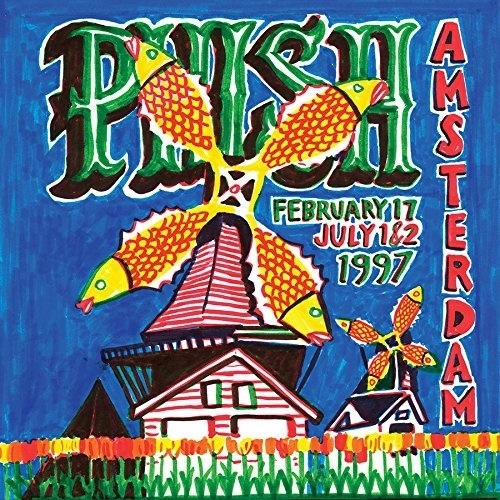
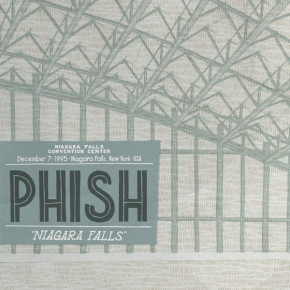
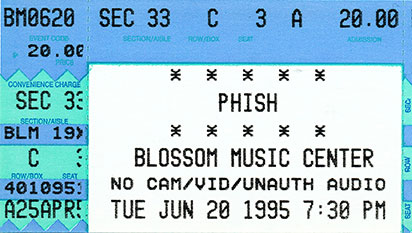

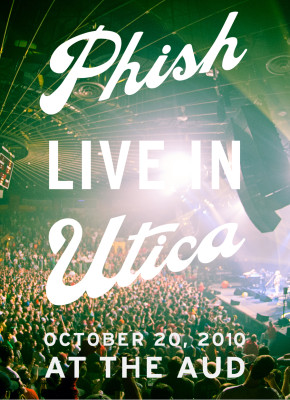
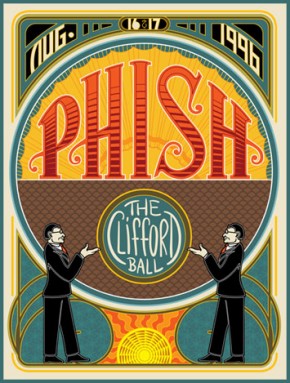
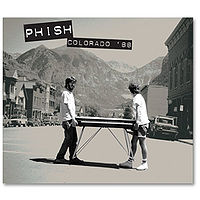

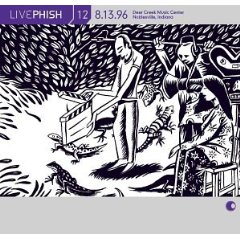
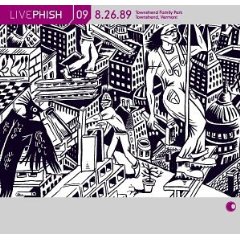
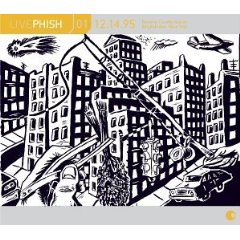


|
| Music/Lyrics | Anastasio/Abrahams/The Dude of Life |
| Vocals | Trey (lead); Page, Mike (backing) |
| Historian | Dan Purcell (sausagemahoney) |
| Last Update | 2016-02-25 |
History
A warhorse set-closer with a glorious closing four-chord jam that is the musical equivalent of the sun slowly rising over the tree line, “Slave to the Traffic Light” is one of the oldest original compositions in the Phish repertoire. Trey has said that he wrote the song as soon as he learned to play an ‘A’ chord on guitar, and its blissful major-chord simplicity is a huge contrast to the knottier, orchestrated numbers Trey would be writing as early as 1985 and 1986 (e.g., “YEM,” “Curtain With” and “Bowie”). The furtive stops and starts in the strutting opening resemble the furtive movement of cars in rush-hour city traffic, and the anguished guitar outbursts in the middle feel like narrowly avoiding a horrible accident, before emerging onto the jam segment’s wide-open highway. Like a moonlight drive on an empty road, it can take you anywhere, and frequently does.
Trey may have written it as a child, but that mostly goes to show you why he’s Trey Anastasio, and you’re not. “Slave” may be compositionally straightforward, but it doesn’t waste a note, with each link in its musical chain stating a new idea and building momentum toward a common goal. Its structure has stayed the same since its first known appearance at one of the earliest Phish shows, 12/1/84 at Nectar’s. The song’s early prominence suggests it was just the thing for a young band to handle in trying to hone their chops and find their style. “Slave” appeared on the band’s White Tape demo, throwing the listener a melodic lifeline out of the chaos of that set. Over the years, its jam segment has come to define what fans call Type-I Jamming, meaning that the band explores the theme without noticeably deviating from it. In the case of “Slave,” that means that the band basically sticks with the jam’s four chords (A-G-D-E, nothing fancy here) throughout a slow, gradual build from the gentle foreplay of Trey’s electric guitar exchanging ideas with Page’s Fender Rhodes electric piano to the hammering climax, by which time Page has one hand on the stately grand piano while the other is creating tidal swells on the B-3, and Trey is mercilessly shredding the fretboard. What I’m saying is, the jam is analogous to fucking. In the 90s, the younger Phish would sometimes rush the slow part to get to the trills and exhortations of the fast part. These days, the band is older and the explosions may be less intense, but still deeply felt.
”Slave to the Traffic Light” – 12/7/95, Niagara Falls, NYBut at the time the formative Usenet group rec.music.phish started in early March 1992 – just in time for the spring tour and the unveiling of the Secret Language – “Slave” was in dry dock. It had fallen out of favor for some reason after the Colorado College show on 4/22/90, going missing for the rest of that year and showing up just twice in 1991, by request on 3/17/91 and finally on 10/24/91. After that, “Slave” wasn’t heard for 241 shows and nearly two years. By that point, a new generation of Phish fans had climbed aboard the bus who had never had the pleasure of hearing “Slave.” For whatever reason, the band came back to the song, appropriately on their visit to the Cincinnati Zoo on 8/6/93. Something clicked during that performance, because the next two versions the band performed (8/20/93 Red Rocks and 12/30/93 CCCC) are two of their finest – arguable top 10 material – and also enjoyed the benefit of anchoring the second sets during two historic shows. Having seen what “Slave” could do in a shed or arena setting, and aiming to conquer those kinds of concert venues from coast to coast, Phish has kept “Slave” in at least moderate rotation ever since. It is always available as a go-to late in the second set and is generally welcomed in that role, even by the most cynical asshole Phish fans.
The renaissance of “Slave” continued in 1994 and 1995, with the song adopting its now familiar role as a go-to second-set closer, an alternative major-chord quiet-to-loud jam on the nights when the band didn’t want to play “Harry Hood.” The stylish lines of the great “Slave’s” from this period still hold up 20-plus years later, but there’s no denying they use a similar plan of attack: a straight line upward at 45 degrees from the most barely audible electric piano hush, to the most freaky and ecstatic guitar shrieks and hollers. Express train, no stops. The band would vary its approach later on, but first it needed to establish the song’s role. Some of the best from these years include the patient Niagara Falls 12/7/95 outing, where Trey’s guitar shines like chrome on the bumper of a vintage Camaro; the simmering, dynamic Halloween 1994 version; the one from Boston Garden on New Year’s Eve that put the exclamation point on 1994, the year Phish conquered America; and 11/12/95, in Gainesville, FL, which (almost, not quite) produced a “Slave” to rival the quality of the “Hood” it had given us on 10/23/94. The version that appeared on A Live One, from Minneapolis on 11/26/94, is a pretty good representation of the traditional “Slave.”
This first era of the mature “Slave,” the slow-motion express-train era, peaked in the summer of 1996 with consecutive barnburners at Deer Creek and The Clifford Ball, the latter still standing 20 years later as a favorite for fans of a certain era. Like the band, “Slave” idled during the fall of 1996, but also like the band, it started to chart new territory, if kinda tentatively, in 1997. No longer was the express train so straight or so direct; no longer did the angle of ascent stay fixed at 45 degrees. The 1997 “Slave” tended to meander and maybe never got quite to the speed we were used to. The best versions from the band’s languid 1997 summer tour – Virginia Beach and Alpine Valley (with its bump segue into “Weekapaug” of all things) – are patient, with all four band members having more of an equal say in things.
”Slave to the Traffic Light” – 10/20/13, Hampton, VA. Video by LazyLightning55a.But if you’re looking for maximum adventure and patience in your performances of “Slave to the Traffic Light,” and I suspect you are, fall 1997 is probably your best bet. These versions have more of a rolling motion, side to side, with a series of more modest peaks rather than one big one. There are a variety of options to choose from here, all great: 11/14/97 Utah, the traditional straight-line approach, but impeccably played and tastefully presented; 12/5/97 Cleveland, the experimental version, the first time “Slave” had approached anything resembling Type-II jamming; 11/21/97 Hampton, the most aching and deeply felt of the ‘97s; or 12/7/97 Dayton, the most smoothly reflective of the funkier, opened-up 1997 approach. After 1997, throughout the rest of 1.0, “Slave” mostly consolidated its winnings as opposed to opening up new markets. During Phish’s first-ever Fourth of July show in 1999, “Slave” emerged gradually, hard to believe but sure enough, from the vapors of a “Ghost” jam, struggling to find the tempo over the thrilled shouts of the crowd. You might also want to check out the “Slave” from 366 days later, on 7/4/00 in Camden, which weaponizes the rolling fall 1997 approach into multiple fierce peaks. Though if we’re being fair, the “Slave” from the midnight set at Big Cypress was just long.
It may be that Phish lost patience again with the relatively simple, closed-ended structure of “Slave” toward the end of 1.0, wondering if they’d done all they could with it. The band shelved it for 20-plus shows in 1999 and again in 2000, dusting it off only sporadically during the short-lived 2.0 era. The best 2.0 “Slave” is probably Philly 2/25/03, and fittingly for 2.0 and its spirit of throwing the Setlist Generator in the trashcan, it comes in the middle of the first set. But one can’t forget Phish’s impression through sound of Tony Montana diving face first into the pile of cocaine, the "Chalk Dust" -> "Slave" > "Chalk Dust" from 12/31/03 in Miami. And it’s surely not for nothing that Phish closed the final set of their final concert ever on 8/15/04 in Coventry, VT, with “Slave.” They knew we wanted to hear it, and, equally important, they knew they would be able to play it.
”Slave to the Traffic Light” – 8/16/15, Columbia, MD. Video by LazyLightning55a.This is the part of the song history where we try to throw a bone to people who never saw Phish in the 1990s and shout out a few notable versions of “Slave” since the band’s 2009 reunion. I’m not sure I can do that with any authority. I know the “Slave” I saw at Dick’s in 2015 was exceptional. The one from the Greek Theater in 2010 has a wonderful, languid tranquility. Factually, the thing to note about “Slave” is that it’s been in frequent rotation, the band relying on it as heavily as ever. But critically, the thing about “Slave” is that it’s always good. I know that’s a copout and cynics will make fun of this notion as anti-critical and thoughtless. Nevertheless, it’s true; “Slave” is always good, and your favorite may well be your last one, until the day you see your next one. I can dig it.
HONORABLE MENTIONS (don’t get mad at me for omitting your favorite): 4/9/94, 12/3/94 (with the Cosmic Country Horns), 11/29/95 (with Béla Fleck), 12/14/95, 8/16/97 (The Great Went), 6/5/09, 8/2/09 (closing the spectacular four-night, long-awaited return to Red Rocks), 7/3/10 (a segue out of a strong "Tweezer"), and 10/10/10 (simply gorgeous).

 The Mockingbird Foundation
The Mockingbird Foundation